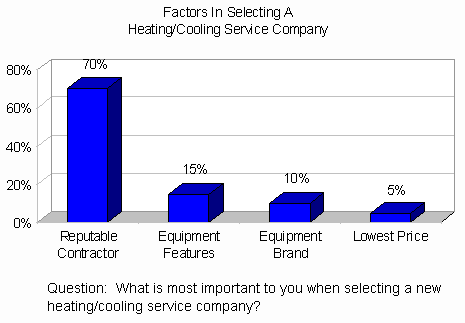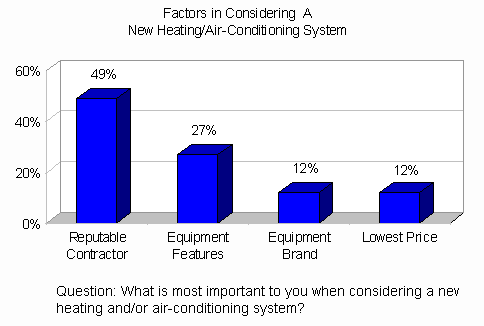What Your Customers Want
by Garry Upton
In-depth research of homeowners verifies the importance of becoming indoor comfort experts and personal comfort advisors. What do homeowners think about their home-comfort systems—and our industry? The following comments were shared with us by homeowners who’ve had recent HVAC service in their homes.
“When I was younger, I didn’t concern myself with long-term
comfort in my house; now that I’m 41, and thinking of
staying in this house a long time, I do.”
“I invited several dealers into my house.”
“I chose one of the two most expensive bids because of the features they offered.”
“My furnace went out in the middle of the night. It was an emergency.
I wanted to add air conditioning but didn’t have the money, so the contractor
added the indoor things needed for me to easily add air-conditioning in
two years—when I can afford it. That was very nice of him. He trusted me
to come back to him when I was ready to add air, and I will.”
“My husband took the low price. We didn’t get what we
wanted, and they weren’t good at telling us about the system.
You get what you pay for.”
New Opportunities And Markets
There are 66.1 million homeowners in the U.S. today, and more than half of them report at least some dissatisfaction with their home’s comfort level. This fact, in and of itself, means little in a society that is prone to moving frequently. People tend to put up with annoyances for short periods of time rather than spend the time and money to correct them.
However, there is a potential for a major change in the home-comfort HVAC market. The leading edge of the baby boomers turned 50 this year, and as the baby boomers age, a large segment of the U.S. population becomes more focused on home-comfort issues (older people are not prone to move often).
Also, the recent trend of big business towards leveraged buy-outs and mass corporate downsizing results in fewer employees who are willing to move at their corporation’s request, unlike employees in earlier decades.
A market is developing—for those contractors who are willing to participate—that consists of homeowners who desire more comfort in their homes, will live in their homes long enough to invest in home-comfort projects, and are looking for consultants who can help them build a home-comfort system over a period of years.
During a recent series of homeowner focus groups sponsored by Honeywell and Contracting Business Magazine, the participants spent much of their time discussing how their homes fell short of their desired comfort requirements.
The participants seemed to share many of the same maladies in their homes’ comfort systems. For example:
- Most had rooms, whole floors, sides of homes, etc. that would not comfortably heat or cool. One participant in each group who was aware of “zoning” became the zoning expert and answered many of the questions posed by others in the group.
- Many believed their thermostats were in the wrong location (too close to the door, too close to the fireplace, too close to a draft, or in a room no one used).
- Some had still not been told about “set-back” (programmable) thermostats, and were dissatisfied with their HVAC contractors for not informing them about such products.
- Many had allergies and were concerned about indoor air quality. Several had learned about filters and filtering devices and were the proud owners of various filter mediums and devices for the home. Homeowners who had added special filtering were pleased with its performance, causing many more to become interested in filtering devices.
- Those without air-conditioning wanted it. Some without air had benefited from forward-thinking dealers who advised adding an indoor coil with a new furnace in an effort to make adding air more affordable at a later date.
- Those with both heating and air-conditioning had a real interest in the humidity levels in their homes (dehumidification in the summer, humidification in the winter). They were interested when the respondents with humidified/dehumidified homes spoke of the comfort that was delivered.
Why Isn’t Opportunity Knocking?
In all of the focus groups, a great deal of interest was generated as the participants who were more informed about “new products” explained the innovations they had added to their home-comfort systems.
With so many people dissatisfied with the comfort level in their homes and wanting to know more about the total comfort that was possible, you might believe contractors’ phones would be ringing off the hook. Unfortunately, nothing could be further from the truth.
It appears, from respondents in these sessions, that communication between contractors and residential customers is limited. Home comfort is talked about between friends and neighbors; however, with so little knowledge about “fixes” to improve the system, there is a tendency on the part of the homeowner to live with the problem or move away from it. In addition, when the system delivers even somewhat acceptable comfort, the homeowner devotes little time to thinking about ways to improve it.
Homeowners know very few “experts” today. They don’t have a relationship with a contractor, and don’t feel they know anyone they can turn to and ask about home fixes. And most consumers don’t know of a contractor whom they feel is a home-comfort expert—even though they would trust one to fix their systems if they break down.
It appears that people distrust HVAC contractors in general until a long-term relationship is developed. And why not? Consumers feel there’s no reason to have a long-term relationship with an HVAC contractor, since contractors (as represented by sales staff and technicians in the home) have not displayed the knowledge base the customer would like in a consultant. Furthermore, comfort recommendations between contractors are inconsistent.
Of course, the news isn’t all bad; some consumers have long-term relationships with contractors, and this group said they believe the contractor knows his business. In other cases, however, consumers said they feel that contractors put them down, or make them feel “dumb,” when they’re explaining about the comfort-enhancing products that are available.
Finally, many consumers—even those who have long-term relationships with contractors—believe the contractor is always in a selling mode and can’t be trusted to recommend what the customer really wants and/or needs.
How To Meet High Expectations
Many homeowners judge the contractor by their perception of the service the contractor offers, from the initial phone call to the sales and technical staff that visit with them in their homes.
Findings in this area include some high expectations. HVAC contractors are generally expected to provide the same type of emergency service that homeowners expect from a hospital—especially in the cold climates where a broken furnace in the middle of the night could lead to frozen water pipes and health risks to children, the elderly, and pets. Contractors who advertise that they provide 24-hour service get praise for doing so.
Having a contractor's answering machine take the calls is generally perceived as negative by consumers, and interactive computer communication (telephone communications that guide the homeowner through a string of questions) is definitely negative.
Consumers are leery of salespeople, yet think highly of project coordinators who sell the job, advise the technicians, and return to inspect the final work. These project coordinators also explain the job to the homeowners, covering aspects such as: the work that was completed; how to use the new equipment; how the home-comfort environments should change, and what changes to look for; what’s covered by the warranty; maintenance suggestions; and suggestions for future comfort adjustments, enhancements, and add-ons.
The homeowners were in general agreement about the type of technician they wanted in their homes. The ideal technician should be great technically and also easy for the customer to talk to. Here’s what consumers think about technicians:
- The same technician should be assigned to the same house over time.
- The technician should be dressed appropriately and look professional.
- The technician should be a “people person,” someone who looks like they enjoy answering homeowners’ questions about the work they are performing.
- The technician should drive a clean, well-marked truck.
- The technician should be aware of homeowner suspicions about people at the door, and stand back from the door until he’s properly recognized.
- The technician should always work as neatly as possible, and clean up after the job has been completed.
- Homeowners wish to be respected by the person servicing their homes, and will be especially pleased with the technician who makes them feel important.
- The technician should be trained to identify possible enhancements to the home’s comfort and should know the best ways to inform the customer of those enhancement opportunities. The task is a difficult one; the customer wants the information, but does not want a heavy-duty sales pitch from the technician.
Become A Comfort Consultant
Despite the hurdles, building long-term rapport with homeowners is possible. One thing that’s very clear from this research is that homeowners would like to find a comfort consultant they can trust and “keep.”
Homeowners who require HVAC service (and who do not have a long-term rapport with a contractor) are always assessing the honesty of the contractor and/or his representatives. While few know how to truly assess honesty, all spend an inordinate amount of time trying.
The contractor who has won a homeowner’s trust must also find ways to stay “top-of-mind” with the homeowner. When service is too infrequent, the homeowner may have a tendency to forget who the honest contractor was that they could trust when the next service is needed.
Contractors who use service contracts as a way to become a homeowner’s comfort consultant can begin to build a true home-comfort system for the homeowner. The contractor can plan additions to the service two or three years in advance, and can plan the changes to coincide with seasonal lulls in business.
Homeowners who have been sold on service agreements as protection for an expensive piece of equipment, similar to an automobile oil change or tune-up, appreciate the service and do not mind spending the going rate for the service.
Having regular contact with their contractor also allows customers to plan early on enhancements like zoning; the addition of air conditioning; and the addition of air-filtration systems, humidifiers, and dehumidifiers, etc. They can afford better systems because they were planned long-term as budgeted items—not emergency expenses.
Contractors who become their customers’ comfort consultants can own their customer base, allowing almost no access to competitors.
Half of all residential homeowners are familiar with seasonal clean-and-check services, having had at least one service check conducted in their current homes; and one-fifth of all homeowners have service contracts. This means that many contractors are ready to take the next step to becoming comfort consultants. Many contractors have a group of service clients with whom a rapport has been built, a group of customers with whom the contractor can begin developing a true “comfort system” for their homes. This is the future of the contracting business—we know because our customers have told us so.


Contact Decision Analyst
For questions about this article please email jthomas@decisionanalyst.com or call 1-800-262-5974 or 1-817-640-6166.
Copyright © 1996 by Decision Analyst, Inc.
This article may not be copied, published, or used in any way without written permission of Decision Analyst.

